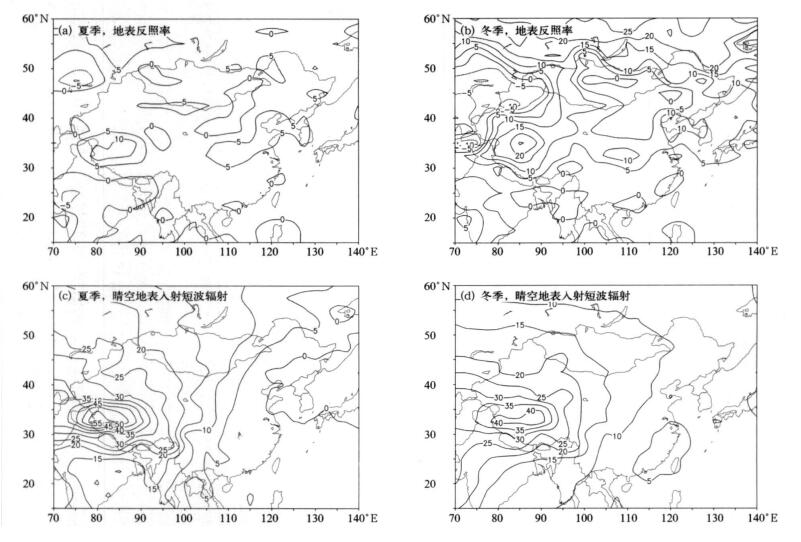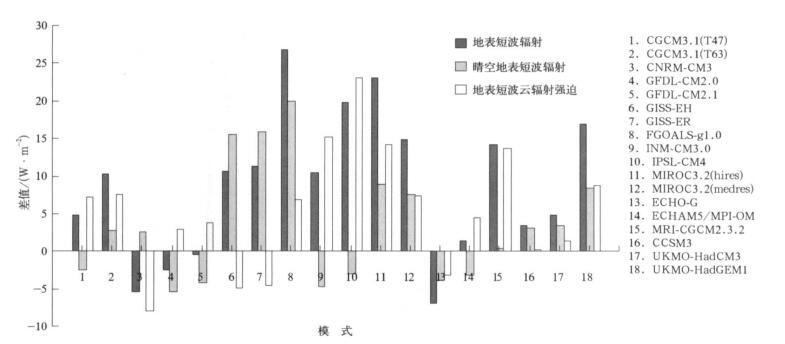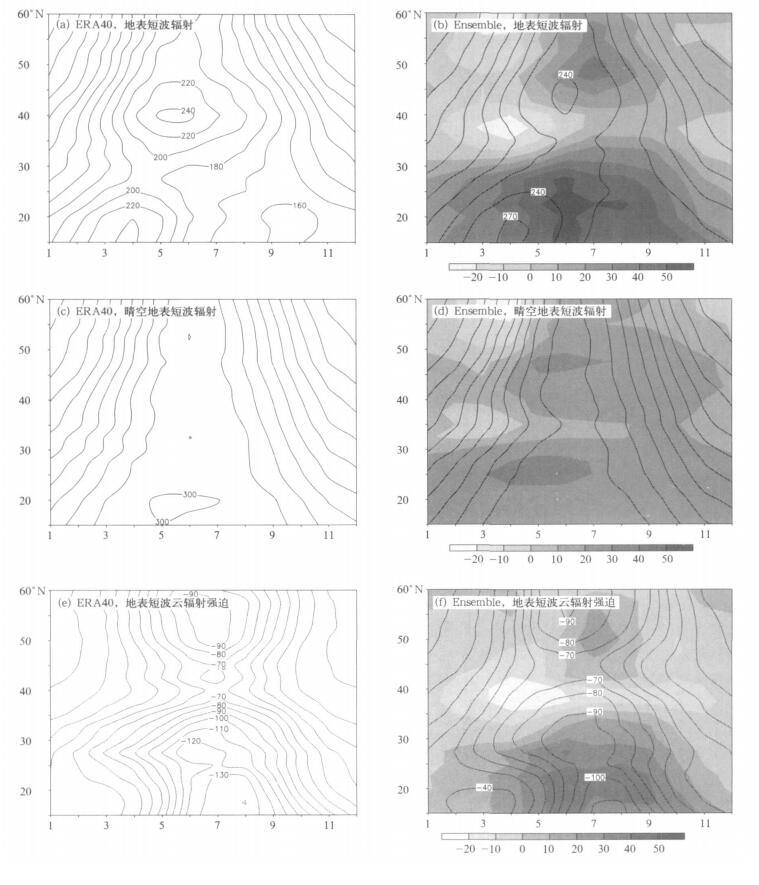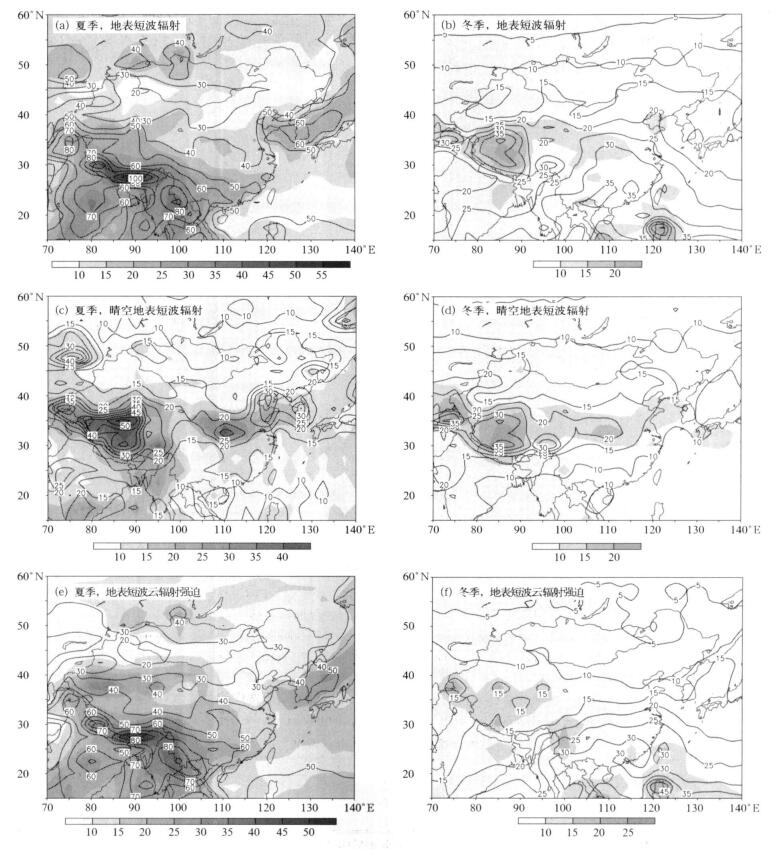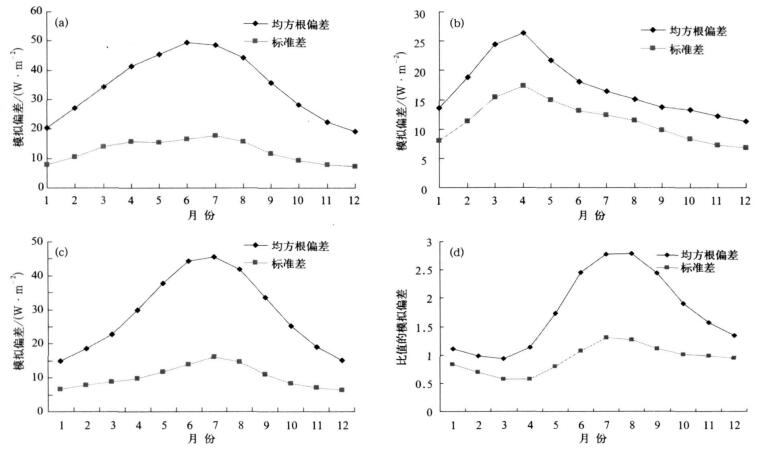全球气候模式对东亚地区地表短波辐射的模拟检验
Validation of Simulation on Surface Shortwave Radiation over East Asia by Global Climate Models
-
摘要: 利用WCRPCMIP3提供的18个全球气候模式输出结果, 检验了其对东亚地区地表短波辐射的模拟能力, 结果表明:多模式集合的多年平均地表短波辐射模拟偏高约8.7 W/m 2, 晴空地表短波辐射模拟偏高约3.4 W/m 2, 地表短波云辐射强迫模拟偏低约5.3 W/m2, 模式间的标准差分别达到9.6, 7.8 W/m2和8 W/ m2; 多模式集合能够很好地模拟出地表短波辐射的纬向平均季节变化的位相特征, 但在量值上还有较大的差距; 模拟偏差分析表明, 多模式集合的区域年平均地表短波辐射、晴空地表短波辐射、地表短波云辐射强迫的均方根偏差分别为34.7, 17.1 W/m 2和29.1 W/ m2, 表明云在地表短波辐射的模拟偏差中起着重要作用; 多模式集合能够很好地模拟出地表入射短波辐射年变化的线性减小趋势, 但模式高估了晴空入射辐射的减小趋势, 而模拟的云辐射强迫变化趋势与ERA 40完全相反。Abstract: Surface shortwave radiation (SSR) plays an important role in surface energy balance.The ability to simulate the disposition and variation of SSR in CGCMs has direct effects on climate projection for the future.Especially the simulation on East Asia monsoon may be affected by the impacts of SSR on surface thermal condition.So it is necessary to validate the ability of CGCMs to simulate SSR in East Asia.By use of 18 CGCMs output provided by WCRPCMIP3 and ERA40 reanalysis data, the ability of GCMs to simulate East Asia SSR is validated through ensemble analysis.The simulation shows remarkable differences among models.The simulated SSR and clear-sky SSR are generally higher than ERA40, while the effect of cloud on SSR (SSCRF) is generally weak.Multi-model ensemble is simulated at about 8.7 W/m2 and 3.4 W/m2 for SSR and clear-sky SSR respectively, and about 5.3 W/m2 lower for SSCRF as compared to ERA40.The standard deviation (STDEV) among different models is 9.6, 7.8 W/m2 and 8 W/m2 for SSR, clear-sky SSR and SSCRF, respectively.The phase characteristics are simulated well for seasonal variation of zonally-averaged SSR, although there is a great gap in magnitude.The simulation is obviously higher in the south of 30°N, especially in summer hemisphere, which is 30—50 W/m2 higher, mainly due to combined effects of low simulation on SSCRF and overestimation of clear-sky SSR both of which have a positive deviation on the SSR simulation. In the north of 30°N, SSR is mainly low by simulation due to the higher simulation of SSCRF.The root mean square deviation (RMSD) in summer is higher than in winter.Multi-model ensemble of RMSD is 34.7, 17.1 W/m2 and 29.1 W/m2 for SSR, clear-sky SSR and SSCRF, respectively, which shows the great effect of cloud on SSR modeling.The STDEV of different model RMSD is 12.5, 11.3 W/m2 and 10.2 W/m2, respectively, showing little difference.The linear decrease in annual downscaling SSR can be simulated rather well by multi-model ensemble. However, for clear-sky downscaling SSR and downscaling SSCRF, the simulation is not good, in other words, the decrease trend of clear-sky downscaling SSR is overestimated by models, while the adverse trend of downscaling SSCRF is given as compared to ERA40.
-
Key words:
- climate model;
- East Asia;
- surface shortwave radiation
-
图 1 多模式集合地表短波辐射、睛空地表短波辐射和地表短波云辐射强迫与ERA的差值
(Ensemble-ERA40)(单位:W/m2, 阴影部分表示通过0.01的显著性检验)
Fig. 1 Difference of surface shortwave radiation (SSR), clear-sky SSR, and surface shortwavw cloud radiative forcing (SSCRF) between multi-model ensemble and ERA40(Ensemble-ERA 40)
(unit :W/m2, shaded areas denote passing the test of 0.01 level)
表 1 多模式集合均方根偏差和模式间标准差之间的空间相关系数
Table 1 Spandard coef ficients between multi-model ensemble of root mean square devlation and inter-model standard deviation

-
[1] Li Z, Moreau L, Arking A. On solar energy disposition. Bull Am Meteorol Soc, 1997, 78 : 53-70 doi: 10.1175/1520-0477(1997)078<0053:OSEDAP>2.0.CO;2 [2] Wild M, Ohmura A, Gilgen H. The disposition of radiative energy in the global climate system: GCM versus observational estimates. Clim Dyn, 1998, 14:853-869 doi: 10.1007/s003820050260 [3] Wild M. Solar radiation budgets in atmospheric model intercomparisons from a surface perspective. Geophys Res Lett, 2005: 32, L07704, doi:10.1029/ 2005GL022421. 850 [4] IPCC. Climate Change 2007: The Physical Science Basis// Solomon S, Qin D, Manning M, et al. Contribution of Working Group I to the Fourth Assessment Report of the Intergovernmental Panel on Climate Change. Cambridge: Cambridge University Press, 2007 [5] Arking A. Absorption of solar energy in the atmosphere:Discrepancy between model and observations. Science, 1996, 273:779-782 doi: 10.1126/science.273.5276.779 [6] Wild M, Ohmura A, Gilgen H, et al. Validation of GCM simulated radiative fluxes using surface observations. J Clim, 1995, 8: 1309-1324 doi: 10.1175/1520-0442(1995)008<1309:VOGCMR>2.0.CO;2 [7] Cusack S, Slingo A A, Edwards J M, et al. The radiative impact of a simple aerosol climatology on the Hadley Centre atmospheric GCM. Q J R Meteorol Soc, 1998, 124: 2517-2526 https://www.researchgate.net/publication/248019720_The_radiative_impact_of_a_simple_aerosol_climatology_on_the_Hadley_Centre_atmospheric_GCM [8] Wild M, Gilgen H, Roesch A, et al. From dimming to brightening: Decadal changes in solar radiation at the Earth's surface. Science, 2005, 308 : 847-850 doi: 10.1126/science.1103215 [9] Che H Z, Shi G Y, Zhang X Y, et al. Analysis of 40 years of solar radiation data from China, 1961--2000. Geophys Res Lett, 2005, 32, L06803, doi: 10.1029/2004GL022322 [10] Liang F, Xia X A. Long term trends in solar radiation and the associated climatic factors over China for 1961--2000. Annales Geophysicae, 2005, 2 : 2424-2432 http://www.oalib.com/paper/1369199 [11] Yu R C, Yu Y Q, Zhang M H. Comparing cloud radiative properties between the Eastern China and the Indian monsoon region. Adv Atmos Sci, 2001, 18(6) : 1090-1102 http://en.cnki.com.cn/Article_en/CJFDTOTAL-DQJZ200106003.htm [12] Wang W C, Gong W, Kau W S, et al. Characteristics of cloud radiative forcing over east China. J Climate, 2004, 17 (4) : 845-853 doi: 10.1175/1520-0442(2004)017<0845:COCRFO>2.0.CO;2 [13] Ramanathan V. The role of earth radiation budget studies in climate and general circulation research. J Atmos Sci, 1987, 37: 447-454 https://www.researchgate.net/publication/248791502_The_role_of_Earth_Radiation_Budget_studies_in_climate_and_general_circulation_research [14] 刘洪利, 朱文琴, 宜树华, 等.中国地区云的气候特征分析.气象学报, 2003, 61(4):466-473 http://www.cnki.com.cn/Article/CJFDTOTAL-QXXB200304007.htm [15] 尹宏.大气辐射学基础.北京:气象出版社, 1993. [16] 张莉.全球海气耦合模式对东亚降水模拟的检验.北京:中国科学院研究生院, 2008 [17] 汪方, 丁一汇, 徐影.辐射参数化方案对一个海气耦合模式云和辐射模拟的影响.应用气象学报, 2007, 18(3):257-265. http://qikan.camscma.cn/jams/ch/reader/view_abstract.aspx?file_no=20070346&flag=1 -


 设为首页
设为首页 加入收藏
加入收藏


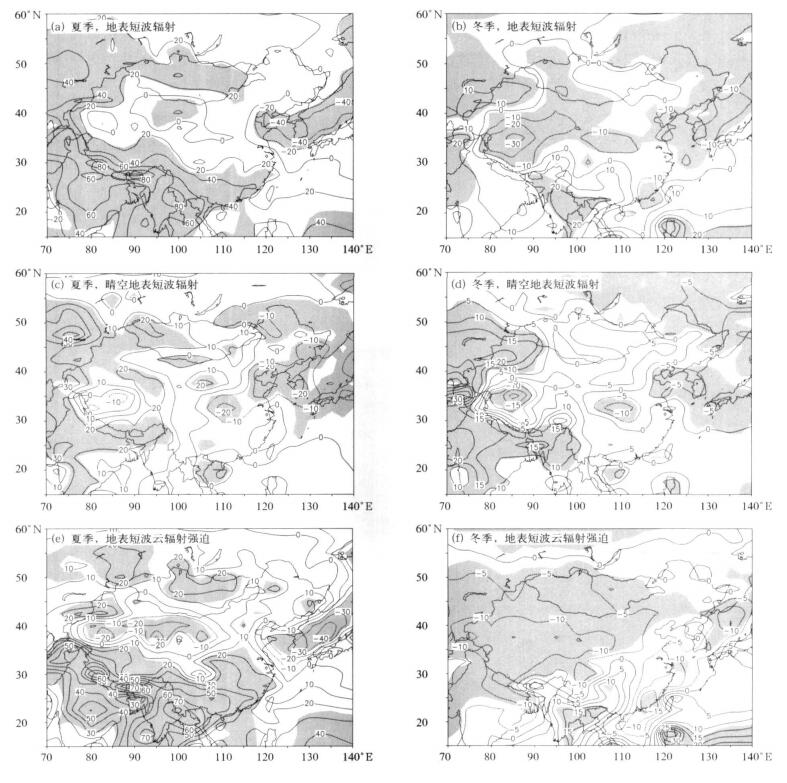
 下载:
下载:
